A new nerve interface can simulate a sense of touch from 20 spots on a prosthetic hand. There have been remarkable mechanical advances in prosthetic limbs in recent years, including rewiring nerve fibers to control sophisticated mechanical arms and brain interfaces that allow for complicated thought control. But for all this progress, prosthetic limbs cannot send back sensory information to the wearer, making it harder for them to do tasks like pick up objects without crushing them or losing their grip.
Now researchers at the Cleveland Veterans Affairs Medical Center and Case Western Reserve University have developed a new kind of interface that can convey a sense of touch from 20 spots on a prosthetic hand. It does this by directly stimulating nerve bundles—known as peripheral nerves—in the arms of patients; two people have so far been fitted with the interface. What’s more, the implants continue to work after 18 months, a noteworthy milestone given that electrical interfaces to nerve tissue can gradually degrade in performance.







